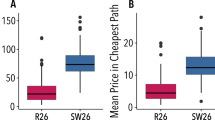Abstract
For many bulk commodities, such as mineral ores, crude oil, building materials and food grains, the suppliers are increasingly in the position of being price-takers. This means that, in the short run, their main decisions relate to spatial choice of markets and setting of production levels within the currently available capacity. In this paper, an entropy maximisation framework is introduced to handle dispersion about the profit-maximising choice of markets and production levels by the suppliers. The model also uses information theory to implicitly account for certain rigidities in trading relationships resulting from non-price factors. Although demand functions must be provided exogenously, cost functions can be inferred from regional vintage production data, which in turn allow profit functions to be defined for each producing region or country. A unique and stable dispersed price equilibrium of the Walrasian type is established for this spatial system under quite general conditions.
Similar content being viewed by others
References
Anas A (1983) Discrete choice theory and the multinomial logit and gravity models. Transp Res B 17:13–23
Armington PS (1969) A theory of demand for products distinguished by place of production. IMF Staff Papers 16:159–176
Batten DF (1983) Spatial analysis of interacting economies. Martinus Nijhoff, Boston
Batten DF, Johansson B (1985) Price adjustments and multiregional rigidities in the analysis of world trade. Pap Reg Sci Assoc 56:145–166
Batten DF, Westin L (1989) Modelling commodity flows on trade networks: retrospect and prospect. Umeå Economics Studies Report No. 194, Department of Economics, University of Umeå (to be published in Festschrift in honour of Walter Isard)
Bröcker J (1988) Interregional trade and economic integration: a partial equilibrium analysis. Reg Sci Urban Econ 18:261–281
Bröcker J (1989) Interregional trade models and convex optimization — a dual approach. Ann Reg Sci (submitted for publication)
Harker P (1988) Dispersed spatial price equilibrium. Environ Planning A 20:353–368
Intriligator MD (1971) Mathematical optimization and economic theory. Prentice-Hall, New Jersey
Lesse PF (1982) A phenomenological theory of socio-economic systems with spatial interactions. Environ Planning A, 14:869–888
Nagurney A (1987) Computational comparisons of spatial price equilibrium methods. J Reg Sci 27:55–76
Ortega JM, Rheinboldt WC (1970) Iterative solutions of nonlinear equations in several variables. Academic Press, New York
Pang J-S (1984) Solution of the general multicommodity spatial equilibrium problem by variational and complementarity methods. J Reg Sci 24:403–414
Roy JR (1987) An alternative information theory approach for modelling spatial interaction. Environ Planning A 19:385–394
Roy JR, Johansson B, Leonardi G (1985) Some spatial equilibria in facility investment under uncertain demand. Pap Reg Sci Assoc 56:215–228
Roy JR, Lesse PF (1981) On appropriate microstate descriptions in entropy modelling. Transp Res B 15:85–96
Samuelson PA (1952) Spatial price equilibrium and linear programming. Am Econ Rev 42:283–303
Smith TE (1978) A cost-efficiency principle of spatial interaction behaviour. Reg Sci Urban Econ 8:313–338
Snickars F, Weibull JW (1977) A minimum information principle: theory and practice. Reg Sci Urban Econ 7:137–168
Takayama T, Judge GG (1971) Spatial and temporal price and allocation models. Elsevier-North Holland, New York
Theil H (1967) Economics and information theory. North-Holland, Amsterdam
Walsh PK, Gibberd RW (1983) A probability analysis of some spatial interaction models. Transp Res B 17:193–200
Webber MJ (1979) Information theory and urban spatial structure. Croom Helm, London
Wilson AG (1970) Entropy in urban and regional modelling. Pion, London
Wilson AG, Coelho JD, Macgill SM, Williams HCWL (1981) Optimization in locational and transport analysis. Wiley, New York
Author information
Authors and Affiliations
Additional information
Lively discussions with David Batten and Börje Johansson over the last couple of years were of considerable help in motivating the structure of the model presented in this paper. Also, perceptive in-house reviews by the author's colleagues, Joe Flood and Bertil Marksjö, greatly sharpened up the presentation.
Rights and permissions
About this article
Cite this article
Roy, J.R. A dispersed equilibrium commodity trade model. Ann Reg Sci 24, 13–28 (1990). https://doi.org/10.1007/BF01579891
Received:
Accepted:
Issue Date:
DOI: https://doi.org/10.1007/BF01579891




